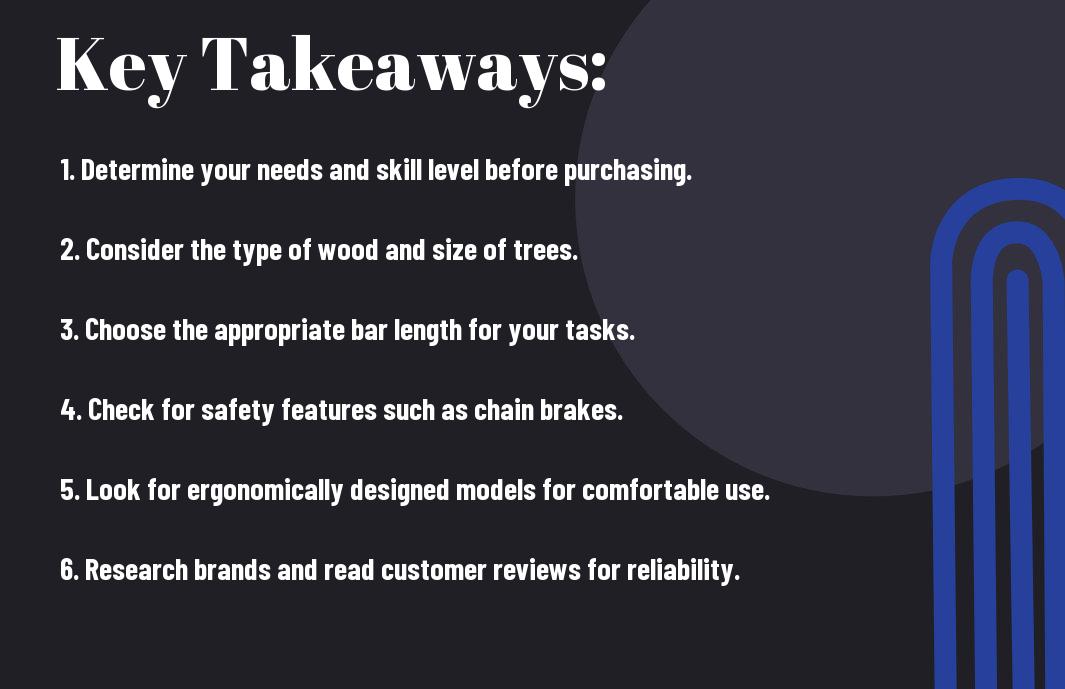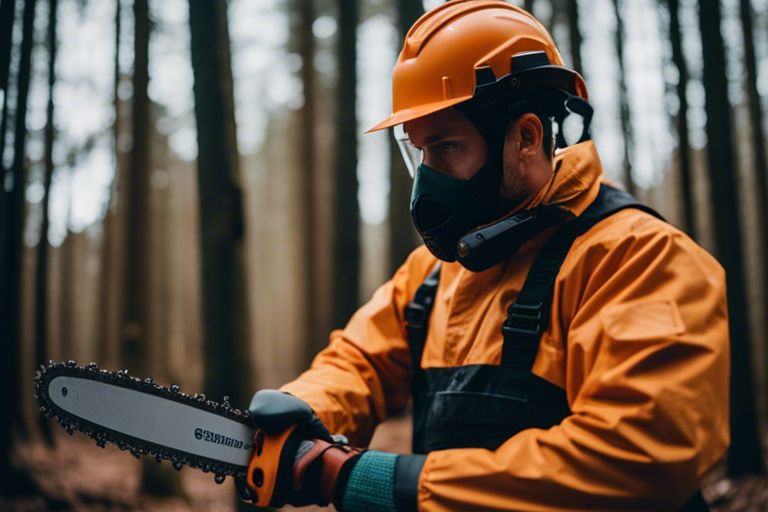Expert Advice for Choosing a Chainsaw
With the plethora of options available when it comes to selecting a chainsaw, it’s crucial to arm yourself with the best advice before making a purchase. From safety features to power sources, this guide will navigate you through the maze of choices. Stay ahead of the game and make an informed decision on which tool will best suit your needs.
Contents
Key Takeaways:
- Consider the size and power: Determine the right chainsaw size and power based on the type of work you plan to do, whether it’s light trimming or heavy-duty logging.
- Look for safety features: Prioritize chainsaws with safety features such as chain brakes, low kickback bars, and handguards to ensure safe operation.
- Think about ease of maintenance: Choose a chainsaw that is easy to maintain, including features like tool-less chain tensioning and access to the air filter and spark plug for simple upkeep.
Determining Your Needs
Identifying the Purpose of the Chainsaw
Your first step in selecting a chainsaw is to identify the purpose for which you will be using it. Do you need it for light pruning and trimming around your yard, or are you planning to tackle larger projects like cutting down trees? Understanding your specific needs will help you narrow down the options and choose the right chainsaw for the job.
Considering the Type of Wood You’ll Be Cutting
To ensure you select a chainsaw powerful enough for your needs, consider the type of wood you will be cutting. Hardwoods like oak and maple require a more robust chainsaw than softwoods like pine. Dense, knotted wood also necessitates a chainsaw with a higher horsepower to cut through efficiently. Make sure to choose a chainsaw with the appropriate power and features for the types of wood you’ll be working with.

Chainsaw Types
One of the first decisions you’ll need to make when choosing a chainsaw is what type of power source you prefer. There are three main types of chainsaws to consider: gas-powered, electric, and cordless. Each type has its own advantages and disadvantages, so it’s important to understand the differences before making your purchase. Below is a breakdown of each type in a convenient table.
| Gas-Powered Chainsaws | Electric Chainsaws |
| Cordless Chainsaws |
Gas-Powered Chainsaws
An efficient and powerful option, gas-powered chainsaws are ideal for heavy-duty cutting tasks. They offer mobility and can handle larger projects with ease.
Electric Chainsaws
Types of electric chainsaws include corded and cordless options. Electric chainsaws are generally lighter and quieter than gas-powered models, making them easier to handle for the average homeowner.
This type of chainsaw is best suited for smaller cutting tasks around the yard. They are lightweight, easy to start, and require less maintenance than gas-powered models. Electric chainsaws are also more environmentally friendly as they produce zero emissions.
Cordless Chainsaws
To achieve portability and freedom of movement, cordless chainsaws are powered by rechargeable batteries. They offer convenience for light to medium cutting tasks without the need for a power outlet.
Chainsaws in this category are perfect for users who value maneuverability and low noise levels. With advancements in battery technology, modern cordless chainsaws can provide impressive power and runtime for various outdoor cutting needs.
Key Features to Consider
After deciding to purchase a chainsaw, it’s crucial to consider several key features to ensure you get the right one for your needs. Here are some important factors to keep in mind:
- Bar Length and Type
- Chain Speed and Pitch
- Power Output and Engine Size
- Safety Features
Bar Length and Type
One of the first key features to consider when choosing a chainsaw is the bar length and type. The length of the bar determines the size of the wood the chainsaw can cut through effectively and the type of bar can affect the chainsaw’s durability and performance.
Chain Speed and Pitch
On the other hand, chain speed and pitch are crucial factors that determine how efficiently the chainsaw can cut through wood. The chain speed refers to how fast the chain moves around the bar, while the pitch indicates the distance between three rivets on the chain. Both of these factors play a significant role in the chainsaw’s cutting ability.
Speed and precision are important when operating a chainsaw. Consider opting for a model with a higher chain speed and suitable pitch to ensure smoother and quicker cutting performance.
Power Output and Engine Size
Type
In the matter of the power output and engine size of a chainsaw, these features determine the overall performance and capability of the tool. A higher power output and engine size generally mean the chainsaw can handle more demanding tasks and tougher materials with ease. Length
Safety Features
One
In the matter of operating a chainsaw, safety features are of utmost importance. Look for chainsaws equipped with safety features such as chain brakes, kickback guards, and anti-vibration systems to ensure safe and comfortable operation. These features can help prevent accidents and protect you from potential harm while using the chainsaw.

Additional Accessories and Tools
Chainsaw Bars and Chains
For additional accessories and tools, consider investing in high-quality chainsaw bars and chains to ensure smooth and efficient cutting. Opt for durable materials that can withstand tough conditions and provide precise cuts.
Protective Gear and Safety Equipment
On the topic of protective gear and safety equipment, always prioritize safety goggles, ear protection, gloves, and a protective helmet when operating a chainsaw. Safety should be your top concern when using this powerful tool.
This imperative gear will protect you from flying debris, loud noise levels, and potential injuries while operating the chainsaw.
Maintenance and Repair Tools
Equipment maintenance is crucial for the longevity of your chainsaw. Invest in quality maintenance and repair tools such as chain sharpeners, wrenches, and lubricants to keep your chainsaw in top condition.
Chainsaw bars and chains require regular maintenance to ensure optimal performance and safety during use.
Budget and Value
Setting a Budget for Your Chainsaw
All chainsaws are not created equal, and neither are their price tags. Your first step in choosing a chainsaw is to determine how much you are willing to invest in this piece of equipment. Consider your needs and the frequency of use to establish a budget that strikes a balance between affordability and quality.
Evaluating the Cost-Effectiveness of Different Models
On the surface, a chainsaw’s price may seem like the deciding factor, but a closer look is necessary to evaluate the cost-effectiveness of different models. Factors such as fuel efficiency, maintenance costs, and durability can significantly impact the long-term value of your investment. Comparing these aspects will ensure that you make a smart choice that balances initial cost with long-term benefits.
Brand and Quality
Researching Reputable Brands
Not all chainsaw brands are created equal. One important step in choosing a chainsaw is researching reputable brands known for their quality and reliability. Look for brands with a history of producing durable, high-performance tools.
Reading Reviews and Ratings
To make an informed decision, this step is crucial. Check out online reviews and ratings from both experts and customers to get a sense of the chainsaw’s performance, durability, and overall satisfaction levels.
This will give you valuable insight into how the chainsaw performs in real-world scenarios and whether it lives up to the manufacturer’s claims. The more positive reviews and higher ratings a chainsaw has, the more likely it is to be a reliable and high-quality tool.
Summing up
Upon reflecting on the expert advice provided for choosing a chainsaw, it is evident that the key to selecting the right tool lies in considering factors such as power source, bar length, safety features, and intended use. By following these guidelines, individuals can make informed decisions and ensure they have the most suitable chainsaw for their needs.
FAQ
Q: What factors should I consider when choosing a chainsaw?
A: When choosing a chainsaw, consider factors such as the size of the trees you will be cutting, your experience level with using chainsaws, the type of work you will be doing (such as occasional yard work or professional logging), and your budget.
Q: Should I choose a gas-powered or electric chainsaw?
A: Gas-powered chainsaws are more powerful and can handle larger jobs, but they require more maintenance and are louder. Electric chainsaws are quieter, easier to maintain, and better for smaller jobs, but they are limited by cord length or battery life.
Q: What safety features should I look for in a chainsaw?
A: When choosing a chainsaw, look for safety features such as a chain brake that stops the chain from moving if kickback occurs, a handguard to protect your hand from debris, and anti-vibration technology to reduce fatigue and strain on your body.



